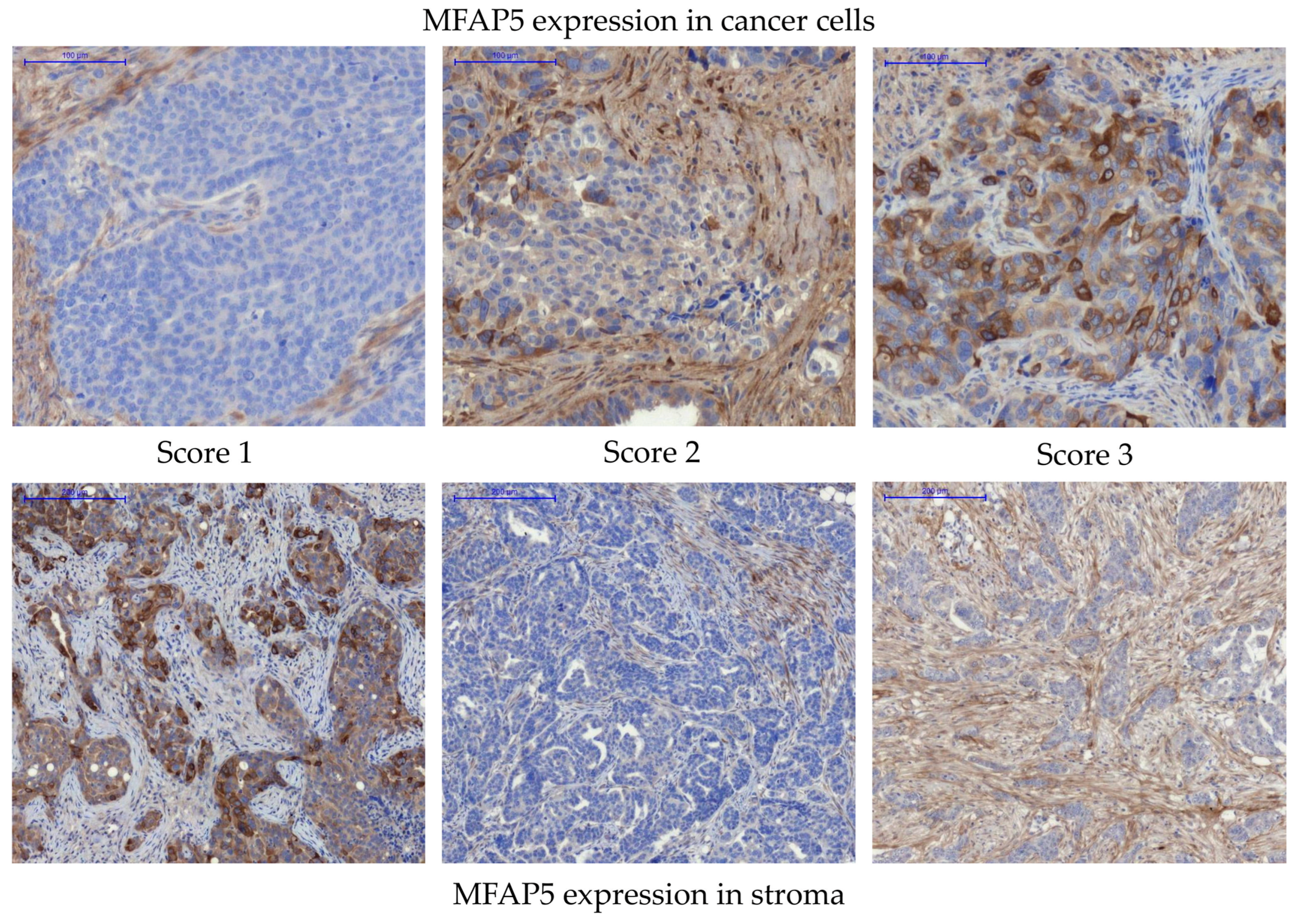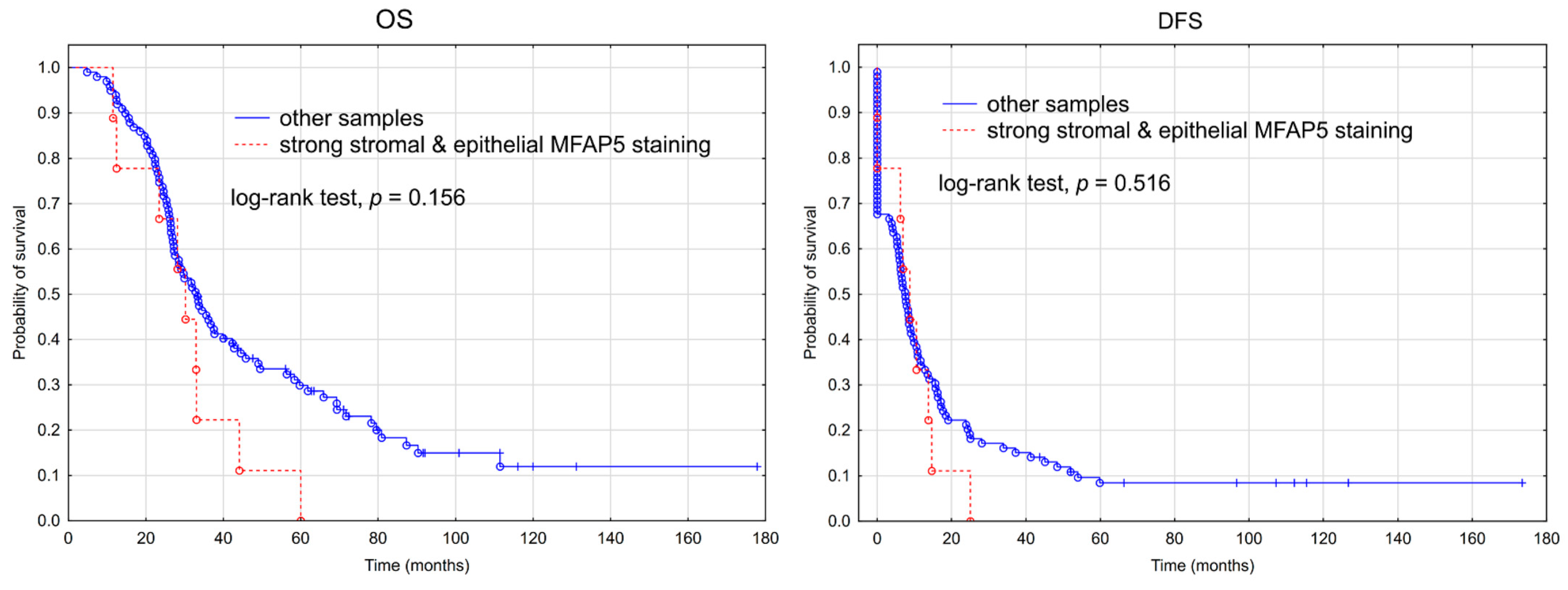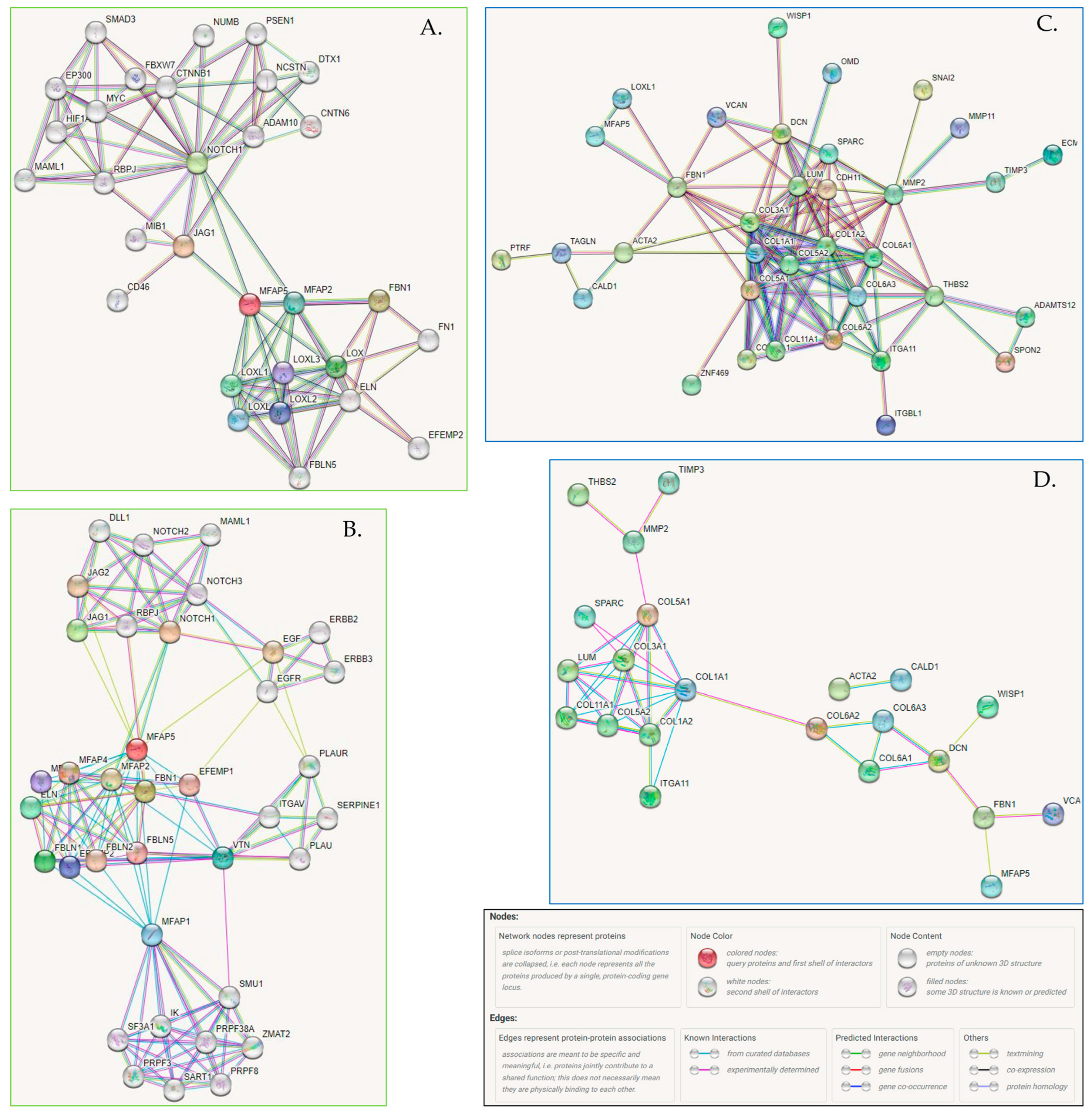Microfibril Associated Protein 5 (MFAP5) Is Related to Survival of Ovarian Cancer Patients but Not Useful as a Prognostic Biomarker
Abstract
1. Introduction
2. Results
2.1. Evaluation of Prognostic Value of MFAP5 mRNA Expression Level
2.2. Evaluation of MFAP5 Protein in Ovarian Cancer Samples
2.3. Prognostic Significance of MFAP5 Protein in Advanced Ovarian Cancer
2.4. Evaluation of MFAP5 Protein in Ovarian Tissue Array
2.5. MFAP5 Expression in Fallopian Tube Samples
2.6. Functional Network of MFAP5 Protein
3. Discussion
3.1. MFAP5 Validation
3.2. Immunohistochemistry versus qRT-PCR
3.3. Large Sample Size and the p-Value Problem
3.4. Possible Role of MFAP5 in Ovarian Cancer
4. Materials and Methods
4.1. Tissue Arrays
4.2. Clinical Samples Used for Survival Analysis
4.3. Immunohistochemistry
4.4. Pathological and Immunohistochemical Evaluation of Tissue Samples
4.5. Statistical Analysis
4.6. Kaplan-Meier Plotter
4.7. CSIOVDB: A Microarray Gene Expression Database of Ovarian Cancer Subtype
4.8. cBioPortal
4.9. STRING: Functional Protein Association Networks
5. Conclusions
Supplementary Materials
Author Contributions
Funding
Institutional Review Board Statement
Informed Consent Statement
Acknowledgments
Conflicts of Interest
References
- Lisio, M.-A.; Fu, L.; Goyeneche, A.; Gao, Z.-H.; Telleria, C. High-Grade Serous Ovarian Cancer: Basic Sciences, Clinical and Therapeutic Standpoints. Int. J. Mol. Sci. 2019, 20, 952. [Google Scholar] [CrossRef] [PubMed]
- Kujawa, K.A.; Lisowska, K.M. Ovarian Cancer—From Biology to Clinic. Postep. Hig. Med. Dosw. 2015, 69, 1275–1290. [Google Scholar] [CrossRef] [PubMed]
- Matulonis, U.A.; Sood, A.K.; Fallowfield, L.; Howitt, B.E.; Sehouli, J.; Karlan, B.Y. Ovarian cancer. Nat. Rev. Dis. Prim. 2016, 2, 16061. [Google Scholar] [CrossRef] [PubMed]
- Neesham, D.; Richards, A.; McGauran, M. Advances in Epithelial Ovarian Cancer. Aust. J. Gen. Pract. 2020, 49, 665–669. [Google Scholar] [CrossRef] [PubMed]
- Mahmood, R.D.; Morgan, R.D.; Edmondson, R.J.; Clamp, A.R.; Jayson, G.C. First-Line Management of Advanced High-Grade Serous Ovarian Cancer. Curr. Oncol. Rep. 2020, 22, 64. [Google Scholar] [CrossRef] [PubMed]
- Armbruster, S.; Coleman, R.L.; Rauh-Hain, J.A. Management and Treatment of Recurrent Epithelial Ovarian Cancer. Hematol. Clin. N. Am. 2018, 32, 965–982. [Google Scholar] [CrossRef] [PubMed]
- Kurnit, K.C.; Fleming, G.F.; Lengyel, E. Updates and New Options in Advanced Epithelial Ovarian Cancer Treatment. Obstet. Gynecol. 2021, 137, 108–121. [Google Scholar] [CrossRef] [PubMed]
- Tan, T.Z.; Yang, H.; Ye, J.; Low, J.; Choolani, M.; Tan, D.S.P.; Thiery, J.-P.; Huang, R.Y.-J. CSIOVDB: A Microarray Gene Expression Database of Epithelial Ovarian Cancer Subtype. Oncotarget 2015, 6, 43843–43852. [Google Scholar] [CrossRef] [PubMed]
- Tothill, R.W.; Tinker, A.V.; George, J.; Brown, R.; Fox, S.B.; Lade, S.; Johnson, D.S.; Trivett, M.K.; Etemadmoghadam, D.; Locandro, B.; et al. Novel Molecular Subtypes of Serous and Endometrioid Ovarian Cancer Linked to Clinical Outcome. Clin. Cancer Res. 2008, 14, 5198–5208. [Google Scholar] [CrossRef]
- The Cancer Genome Atlas Research Network. Integrated Genomic Analyses of Ovarian Carcinoma. Nature 2011, 474, 609–615. [Google Scholar] [CrossRef]
- Lisowska, K.M.; Olbryt, M.; Student, S.; Kujawa, K.A.; Cortez, A.J.; Simek, K.; Dansonka-Mieszkowska, A.; Rzepecka, I.K.; Tudrej, P.; Kupryjańczyk, J. Unsupervised Analysis Reveals Two Molecular Subgroups of Serous Ovarian Cancer with Distinct Gene Expression Profiles and Survival. J. Cancer Res. Clin. Oncol. 2016, 142, 1239–1252. [Google Scholar] [CrossRef] [PubMed]
- Kim, H.; Watkinson, J.; Varadan, V.; Anastassiou, D. Multi-Cancer Computational Analysis Reveals Invasion-Associated Variant of Desmoplastic Reaction Involving Inhba, Thbs2 and Col11a1. BMC Med. Genom. 2010, 3, 51. [Google Scholar] [CrossRef] [PubMed]
- Leung, C.S.; Yeung, T.-L.; Yip, K.-P.; Pradeep, S.; Balasubramanian, L.; Liu, J.; Wong, K.-K.; Mangala, L.S.; Armaiz-Pena, G.N.; Lopez-Berestein, G.; et al. Calcium-Dependent Fak/Creb/Tnnc1 Signalling Mediates the Effect of Stromal Mfap5 on Ovarian Cancer Metastatic Potential. Nat. Commun. 2014, 5, 5092. [Google Scholar] [CrossRef] [PubMed]
- Syrkis, J.P.; Kujawa, K.; Zembala-Nożyńska, E.; Cortez, A.J.; Kupryjańczyk, J.; Lisowska, K. 711 Evaluation of the Lox Gene/Protein as Potential Prognostic Marker in Ovarian Cancer. Int. J. Gynecol. Cancer 2021, 31, 450. [Google Scholar] [CrossRef]
- Cortez, A.J.; Kujawa, K.A.; Wilk, A.M.; Sojka, D.R.; Syrkis, J.P.; Olbryt, M.; Lisowska, K.M. Evaluation of the Role of Itgbl1 in Ovarian Cancer. Cancers 2020, 12, 2676. [Google Scholar] [CrossRef]
- Kujawa, K.A.; Zembala-Nożyńska, E.; Cortez, A.J.; Kujawa, T.; Kupryjańczyk, J.; Lisowska, K.M. Fibronectin and Periostin as Prognostic Markers in Ovarian Cancer. Cells 2020, 9, 149. [Google Scholar] [CrossRef]
- Mok, S.C.; Bonome, T.; Vathipadiekal, V.; Bell, A.; Johnson, M.E.; Wong, K.-K.; Park, D.-C.; Hao, K.; Yip, D.K.; Donninger, H.; et al. A Gene Signature Predictive for Outcome in Advanced Ovarian Cancer Identifies a Survival Factor: Microfibril-Associated Glycoprotein 2. Cancer Cell 2009, 16, 521–532. [Google Scholar] [CrossRef]
- Yeung, T.-L.; Leung, C.S.; Yip, K.-P.; Sheng, J.; Vien, L.; Bover, L.C.; Birrer, M.J.; Wong, S.T.C.; Mok, S.C. Anticancer Immunotherapy by Mfap5 Blockade Inhibits Fibrosis and Enhances Chemosensitivity in Ovarian and Pancreatic Cancer. Clin. Cancer Res. 2019, 25, 6417–6428. [Google Scholar] [CrossRef]
- Tan, T.Z.; Miow, Q.H.; Huang, R.Y.-J.; Wong, M.K.; Ye, J.; Lau, J.A.; Wu, M.C.; Hadi, L.H.B.A.; Soong, R.; Choolani, M.; et al. Functional Genomics Identifies Five Distinct Molecular Subtypes with Clinical Relevance and Pathways for Growth Control in Epithelial Ovarian Cancer. EMBO Mol. Med. 2013, 5, 1051–1066. [Google Scholar] [CrossRef]
- Lisowska, K.M.; Oibryt, M.; Dudaladava, V.; Pamuła-Piłat, J.; Kujawa, K.; Grzybowska, E.; Jarząb, M.; Student, S.; Rzepecka, I.K.; Jarząb, B.; et al. Gene Expression Analysis in Ovarian Cancer—Faults and Hints from DNA Microarray Study. Front. Oncol. 2014, 4, 6. [Google Scholar] [CrossRef]
- Lin, M.; Lucas, H.C., Jr.; Shmueli, G. Research Commentary—Too Big to Fail: Large Samples and the p-Value Problem. Inf. Syst. Res. 2013, 24, 883–1167. [Google Scholar] [CrossRef]
- Serdar, C.C.; Cihan, M.; Yücel, D.; Serdar, M.A. Sample Size, Power and Effect Size Revisited: Simplified and Practical Approaches in Pre-Clinical, Clinical and Laboratory Studies. Biochem. Medica 2021, 31, 27–53. [Google Scholar] [CrossRef] [PubMed]
- Sullivan, G.M.; Feinn, R. Using Effect Size—Or Why the P Value Is Not Enough. J. Grad. Med. Educ. 2012, 4, 279–282. [Google Scholar] [CrossRef] [PubMed]
- Cortez, A.J.; Kujawa, K.A.; Olbryt, M.; Tudrej, P.A.; Lisowska, K.M. Establishment of in vitro Model System Designed for Functional Studies of Secreted Genes in Ovarian Cancer Biology. In Proceedings of the PCS Global Obstetrics and Gynaecology Congress, Prague, Czech Republic, 18–19 June 2016. [Google Scholar]
- Nowak-Markwitz, E.; Spaczyński, M. Ovarian Cancer--Modern Approach to Its Origin and Histogenesis. Ginekol. Polska 2012, 83, 454–457. [Google Scholar]
- Reade, C.J.; McVey, R.M.; Tone, A.A.; Finlayson, S.J.; McAlpine, J.N.; Fung-Kee-Fung, M.; Ferguson, S.E. The Fallopian Tube as the Origin of High Grade Serous Ovarian Cancer: Review of a Paradigm Shift. J. Obstet. Gynaecol. Can. 2014, 36, 133–140. [Google Scholar] [CrossRef] [PubMed]
- Soong, T.R.; Howitt, B.E.; Horowitz, N.; Nucci, M.R.; Crum, C.P. The Fallopian Tube, “Precursor Escape” and Narrowing the Knowledge Gap to the Origins of High-Grade Serous Carcinoma. Gynecol. Oncol. 2019, 152, 426–433. [Google Scholar] [CrossRef] [PubMed]
- Soong, T.R.; Howitt, B.E.; Miron, A.; Horowitz, N.S.; Campbell, F.; Feltmate, C.M.; Muto, M.G.; Berkowitz, R.S.; Nucci, M.R.; Xian, W.; et al. Evidence for Lineage Continuity between Early Serous Proliferations (Esps) in the Fallopian Tube and Disseminated High-Grade Serous Carcinomas. J. Pathol. 2018, 246, 344–351. [Google Scholar] [CrossRef] [PubMed]
- Beaufort, C.M.; Helmijr, J.C.A.; Piskorz, A.M.; Hoogstraat, M.; Ruigrok-Ritstier, K.; Besselink, N.; Murtaza, M.; van Ijcken, W.; Heine, A.; Smid, M.; et al. Ovarian Cancer Cell Line Panel (Occp): Clinical Importance of In Vitro Morphological Subtypes. PLoS ONE 2014, 9, e103988. [Google Scholar] [CrossRef]
- Domcke, S.; Sinha, R.; Levine, D.A.; Sander, C.; Schultz, N. Evaluating Cell Lines as Tumour Models by Comparison of Genomic Profiles. Nat. Commun. 2013, 4, 2126. [Google Scholar] [CrossRef]
- Tudrej, P.; Kujawa, K.A.; Cortez, A.J.; Lisowska, K.M. Characteristics of in vitro Model Systems for Ovarian Cancer Studies. Oncol. Clin. Pract. 2019, 15, 246–259. [Google Scholar] [CrossRef]
- Gibson, M.A.; Hatzinikolas, G.; Kumaratilake, J.S.; Sandberg, L.B.; Nicholl, J.K.; Sutherland, G.R.; Cleary, E.G. Further Characterization of Proteins Associated with Elastic Fiber Microfibrils Including the Molecular Cloning of Magp-2 (Mp25). J. Biol. Chem. 1996, 271, 1096–1103. [Google Scholar] [CrossRef] [PubMed]
- Gibson, M.A.; Leavesley, D.I.; Ashman, L.K. Microfibril-Associated Glycoprotein-2 Specifically Interacts with a Range of Bovine and Human Cell Types via αVβ3 Integrin. J. Biol. Chem. 1999, 274, 13060–13065. [Google Scholar] [CrossRef] [PubMed]
- Mecham, R.P.; Gibson, M.A. The Microfibril-Associated Glycoproteins (Magps) and the Microfibrillar Niche. Matrix Biol. 2015, 47, 13–33. [Google Scholar] [CrossRef]
- Fabbro, D.; Bauer, M.; Murone, M.; Lehal, R. Notch Inhibition in Cancer: Challenges and Opportunities. CHIMIA 2020, 74, 779–783. [Google Scholar] [CrossRef]
- Albig, A.R.; Becenti, D.J.; Roy, T.G.; Schiemann, W.P. Microfibril-Associate Glycoprotein-2 (Magp-2) Promotes Angiogenic Cell Sprouting by Blocking Notch Signaling in Endothelial Cells. Microvasc. Res. 2008, 76, 7–14. [Google Scholar] [CrossRef] [PubMed]
- Barber, H.R.; Sommers, S.C.; Synder, R.; Kwon, T.H. Histologic and Nuclear Grading and Stromal Reactions as Indices for Prognosis in Ovarian Cancer. Am. J. Obstet. Gynecol. 1975, 121, 795–807. [Google Scholar] [PubMed]
- Kupryjanczyk, J.; Kraszewska, E.; Ziolkowska-Seta, I.; Madry, R.; Timorek, A.; Markowska, J.; Stelmachow, J.; Bidzinski, M.; the Polish Ovarian Cancer Study Group (POCSG). TP53 Status and Taxane-Platinum versus Platinum-Based Therapy in Ovarian Cancer Patients: A Non-Randomized Retrospective Study. BMC Cancer 2008, 8, 27. [Google Scholar] [CrossRef]
- Ziółkowska-Seta, I.; Mądry, R.; Kraszewska, E.; Szymańska, T.; Timorek, A.; Rembiszewska, A.; Kupryjańczyk, J. Tp53, Bcl-2 and Bax Analysis in 199 Ovarian Cancer Patients Treated with Taxane-Platinum Regimens. Gynecol. Oncol. 2009, 112, 179–184. [Google Scholar] [CrossRef]
- Gyorffy, B.; Lánczky, A.; Szallasi, Z. Implementing an Online Tool for Genome-Wide Validation of Survival-Associated Biomarkers in Ovarian-Cancer Using Microarray Data from 1287 Patients. Endocr. Relat. Cancer 2012, 19, 197–208. [Google Scholar] [CrossRef]
- Li, Q.; Birkbak, N.J.; Gyorffy, B.; Szallasi, Z.; Eklund, A.C. Jetset: Selecting the Optimal Microarray Probe Set to Represent a Gene. BMC Bioinform. 2011, 12, 474. [Google Scholar] [CrossRef]
- Cerami, E.; Gao, J.; Dogrusoz, U.; Gross, B.E.; Sumer, S.O.; Aksoy, B.A.; Jacobsen, A.; Byrne, C.J.; Heuer, M.L.; Larsson, E.; et al. The Cbio Cancer Genomics Portal: An Open Platform for Exploring Multidimensional Cancer Genomics Data. Cancer Discov. 2012, 2, 401–404. [Google Scholar] [CrossRef] [PubMed]
- Gao, J.; Aksoy, B.A.; Dogrusoz, U.; Dresdner, G.; Gross, B.E.; Sumer, S.O.; Sun, Y.; Jacobsen, A.; Sinha, R.; Larsson, E.; et al. Integrative Analysis of Complex Cancer Genomics and Clinical Profiles Using the Cbioportal. Sci. Signal. 2013, 6, pl1. [Google Scholar] [CrossRef] [PubMed]
- Szklarczyk, D.; Gable, A.L.; Lyon, D.; Junge, A.; Wyder, S.; Huerta-Cepas, J.; Simonovic, M.; Doncheva, N.T.; Morris, J.H.; Bork, P.; et al. String v11: Protein–Protein Association Networks with Increased Coverage, Supporting Functional Discovery in Genome-Wide Experimental Datasets. Nucleic Acids Res. 2019, 47, D607–D613. [Google Scholar] [CrossRef] [PubMed]






| Factor | Details | Cox Coefficient | p-Value | Hazard Ratio |
|---|---|---|---|---|
| stage | I, II vs. III, IV; reference III, IV | 1.40 | <0.001 | 4.06 |
| grade | G1 vs. G2, G3; reference G2 & G3 | 0.65 | 0.091 | 1.92 |
| surgical debulking | optimal vs. suboptimal; reference suboptimal | 0.20 | 0.035 | 1.22 |
| histology | non-serous vs. serous; reference serous | 1.30 | 0.009 | 3.67 |
| age | <55 vs. ≥55; reference ≥ 55 | 0.16 | 0.076 | 1.18 |
| MFAP5 | <median vs. ≥median; reference ≥ median | <0.001 | 0.998 | 1.00 |
| Factor | Details | Cox Coefficient | p-Value | Hazard Ratio |
|---|---|---|---|---|
| stage | I, II vs. III, IV; reference III, IV | 1.26 | <0.001 | 3.53 |
| grade | G1 vs. G2, G3; reference G2 & G3 | 0.32 | 0.355 | 1.37 |
| surgical debulking | optimal vs. suboptimal; reference suboptimal | 0.25 | 0.008 | 1.28 |
| histology | non-serous vs. serous; reference serous | 1.09 | <0.001 | 2.98 |
| age | <55 vs. ≥55; reference ≥ 55 | 0.18 | 0.042 | 1.20 |
| MFAP5 | <median vs. ≥median; reference ≥ median | 0.16 | 0.062 | 1.18 |
| Characteristics (Total Number) | Number of Samples in Each Category | ||||||||
|---|---|---|---|---|---|---|---|---|---|
| Residual tumor 1 | (108) | R0 | 17 | R1 | 27 | R2 | 21 | R3 | 43 |
| CHT response (acc. To RECIST^) 2 | (108) | CR | 74 | PR | 31 | NC | 1 | P | 2 |
| Histopathological type | (108) | serous | 97 | undifferentiated | 10 | other | 1 | ||
| Tumor grade | (108) | G2 | 2 | G3 | 76 | G4 * | 30 | ||
| Platinum sensitivity 3 | (108) | Highly sensitive | 22 | Moderately sensitive | 42 | Resistant | 44 | ||
| p53 accumulation | (108) | Yes | 68 | No | 40 | ||||
| Age | (108) | ≤54 years | 56 | >54 years | 52 | ||||
Publisher’s Note: MDPI stays neutral with regard to jurisdictional claims in published maps and institutional affiliations. |
© 2022 by the authors. Licensee MDPI, Basel, Switzerland. This article is an open access article distributed under the terms and conditions of the Creative Commons Attribution (CC BY) license (https://creativecommons.org/licenses/by/4.0/).
Share and Cite
Kujawa, K.A.; Zembala-Nożynska, E.; Syrkis, J.P.; Cortez, A.J.; Kupryjańczyk, J.; Lisowska, K.M. Microfibril Associated Protein 5 (MFAP5) Is Related to Survival of Ovarian Cancer Patients but Not Useful as a Prognostic Biomarker. Int. J. Mol. Sci. 2022, 23, 15994. https://doi.org/10.3390/ijms232415994
Kujawa KA, Zembala-Nożynska E, Syrkis JP, Cortez AJ, Kupryjańczyk J, Lisowska KM. Microfibril Associated Protein 5 (MFAP5) Is Related to Survival of Ovarian Cancer Patients but Not Useful as a Prognostic Biomarker. International Journal of Molecular Sciences. 2022; 23(24):15994. https://doi.org/10.3390/ijms232415994
Chicago/Turabian StyleKujawa, Katarzyna Aleksandra, Ewa Zembala-Nożynska, Joanna Patrycja Syrkis, Alexander Jorge Cortez, Jolanta Kupryjańczyk, and Katarzyna Marta Lisowska. 2022. "Microfibril Associated Protein 5 (MFAP5) Is Related to Survival of Ovarian Cancer Patients but Not Useful as a Prognostic Biomarker" International Journal of Molecular Sciences 23, no. 24: 15994. https://doi.org/10.3390/ijms232415994
APA StyleKujawa, K. A., Zembala-Nożynska, E., Syrkis, J. P., Cortez, A. J., Kupryjańczyk, J., & Lisowska, K. M. (2022). Microfibril Associated Protein 5 (MFAP5) Is Related to Survival of Ovarian Cancer Patients but Not Useful as a Prognostic Biomarker. International Journal of Molecular Sciences, 23(24), 15994. https://doi.org/10.3390/ijms232415994






